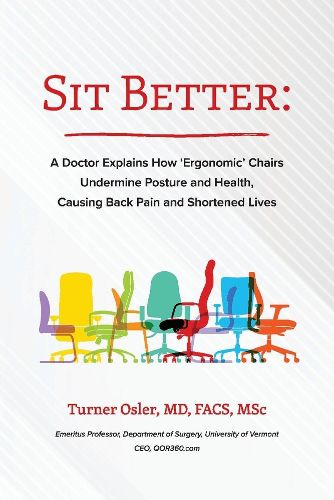Readings Newsletter
Become a Readings Member to make your shopping experience even easier.
Sign in or sign up for free!
You’re not far away from qualifying for FREE standard shipping within Australia
You’ve qualified for FREE standard shipping within Australia
The cart is loading…






Sit Better is a groundbreaking guide to the complicated, counterintuitive world of sitting. Author Dr. Turner Osler is a retired surgeon and a lifelong academic researcher with interests in public health and epidemiology. Throughout this book, he carefully shows that our switch to a chair-centered life has been a catastrophe for our posture, our core strength, our back health, and especially to our overall wellbeing. Sitting shortens our lives by two years on average. Although the book intends to show the inherent dangers of sitting, it also offers hopeful guidance so readers can avoid the harms of sitting and optimize their health and longevity.
For the first three million years of human history our hunter/gatherer forebears lead lives filled with physical activity. Chairs were unimagined and squatting was the typical resting posture - a posture that required considerable muscular engagement. Over this long history, humans came to require daily activity to remain vital and healthy. So, it was unfortunate when chairs and sitting burst onto this scene just 100 years ago.
We instantly fell in love with chair sitting, and most of us now sit for over 8 hours a day. It’s estimated that there are over 70 chairs for every person in America. Unfortunately, humans are not adapted for the long periods of muscular inactivity encouraged by ergonomic chairs, and the health consequences have been catastrophic.
Despite this grim news, Dr. Osler is optimistic. He believes that if we can change how much we sit, how long we sit for, and especially how we sit, the harms of sitting can be avoided. Indeed, he holds out the hope that sitting can be made healthful by switching to chairs that make sitting active, rather than passive. So, could sitting be harnessed to add more movement to our days? Dr. Osler shows how it’s possible.
$9.00 standard shipping within Australia
FREE standard shipping within Australia for orders over $100.00
Express & International shipping calculated at checkout
Sit Better is a groundbreaking guide to the complicated, counterintuitive world of sitting. Author Dr. Turner Osler is a retired surgeon and a lifelong academic researcher with interests in public health and epidemiology. Throughout this book, he carefully shows that our switch to a chair-centered life has been a catastrophe for our posture, our core strength, our back health, and especially to our overall wellbeing. Sitting shortens our lives by two years on average. Although the book intends to show the inherent dangers of sitting, it also offers hopeful guidance so readers can avoid the harms of sitting and optimize their health and longevity.
For the first three million years of human history our hunter/gatherer forebears lead lives filled with physical activity. Chairs were unimagined and squatting was the typical resting posture - a posture that required considerable muscular engagement. Over this long history, humans came to require daily activity to remain vital and healthy. So, it was unfortunate when chairs and sitting burst onto this scene just 100 years ago.
We instantly fell in love with chair sitting, and most of us now sit for over 8 hours a day. It’s estimated that there are over 70 chairs for every person in America. Unfortunately, humans are not adapted for the long periods of muscular inactivity encouraged by ergonomic chairs, and the health consequences have been catastrophic.
Despite this grim news, Dr. Osler is optimistic. He believes that if we can change how much we sit, how long we sit for, and especially how we sit, the harms of sitting can be avoided. Indeed, he holds out the hope that sitting can be made healthful by switching to chairs that make sitting active, rather than passive. So, could sitting be harnessed to add more movement to our days? Dr. Osler shows how it’s possible.